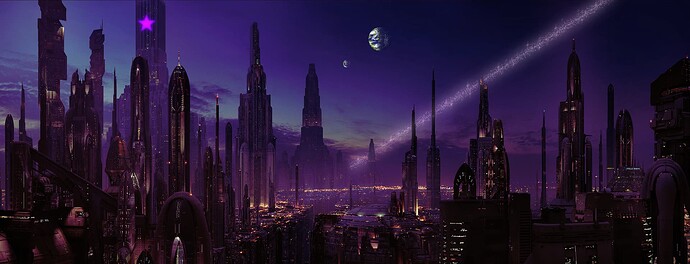The Commerical District of Galactya, the Capital Ecumenopolis of the Galactyan Empire.
Overview
The Celestial Empire Of Galactya is an ancient Interstellar Empire located in the Center-West of Sector A1-0. The Galactyan Empire controls more than 31 thousand star systems, together with billions of smaller habitats and many megastructures. As of 0 BBT, it has a population of 81.5 trillion, the third highest in the Sector, divided between uncountable numbers of species. For convenience, the many Galactyan species are often considered as just one, and referred to as “Galactyans”.
Throughout the Empire, many ISO Nodes can be found, ranging from small computronium clusters to giant megastructures like Jupiter Brains and Matryoshka Swarms. These megastructures either host the Empire’s civilian virchworld, important communication nodes or transapient intelligences, including Godlings and Archailects.
The Capital of the Galactyan Empire is the homonymously named planet of Galactya in the binary Crus-Lux system, the most populous ecumenopolis in the Sector, numbering at 7.6 trillion citizens.
An Economic, Political and Industrial Superpower, the Galactyan Empire is widely considered to be the central member of the Coalition Of United Stars (COUS) a powerful supranational alliance consisting of 6 other nations.
The Empire is strongly terraformist, and favours building many habitable habitats and megastructures to maximise opportunities for life. The Empire is very centered around technological advancement, and while highly experimental, it takes utmost care not to create unnecessarily dangerous situations that might spiral out of control.
The Galactyan Empire is heavily xenophilic, interventionist and peaceful: however, if it or one of it’s allies is threatened, Galactya will not hesitate to attack aggressively with it’s full might.
A Kinisian Zoetrope: movement and change are the foundations of their culture and ideology.
Culture
Many vastly different cultures exist, thanks to the Empire giving it’s worlds, habitats and megastructures a high degree of autonomy over their cultural and social development. However, all cultures share the Core Galactyan Principles, with the Principle Of Equality being the one that the Empire is willing to impose with force.
Many cultures originating from alien nations and their Galactyan sects have gained large traction between the population, brought into the Imperial Culturescape by immigrating groups and clades.
These immigrating cultures all have basic principles and core ideologies that are similar to the Core Galactyan Principles: if they do not, they will either mutate over time to better fit with Galactyan society or, if the difference is too great, will be expelled from the Empire.
There are rumors that the Empire employs it’s transapients to memetically manipulate certain groups in order to change their culture into something more fitting for Galactyan Society; however, none of these rumors have been confirmed thus far.
Elemmírë, the temple complex center of all Visten Religion.
Religion
Like with it’s cultures, religions in the Galactyan Empire are many, and vastly different between one another. While very few species of the main Galactyan Clade are religious, many other Clades have developed their own religions, with alien Clades and immigrants bringing their own beliefs with them.
Many religions originating from alien nations and their Galactyan sects have gained large traction between the population, brought into the Imperial Religiouscape by immigrating groups and clades. Oftentimes, a culture will have it’s own religion attached to it; other times, religions themselves are subsects of a culture that assumed more spiritual and religious traits over time.
In a similar manner to cultures, religions usually have basic principles and core ideologies that are similar to the Core Galactyan Principles: if they do not, they will either mutate over time to better fit with Galactyan society or, if the difference is too great, will be expelled from the Empire.
While Galactya doesn’t have an official one, many religions have become “Protected” by the Empire.
A Galactyan Nicoll-Dyson Array in the Robilune Star System, destroying an entire fleet of U’Lnuibian Warships during the Second Interstellar War.
History
The Galactyan Empire is one of the oldest nations in the Sector- the third oldest in fact - so much so that most contemporary civilizations were well into the neolithic or bronze ages when the Empire was founded 9700 years ago.
Early Galactyan History - all the way from the Foundation of the Empire to the First Interstellar War - was characterized by continuous secessions and attempts to create independent states separate from the Empire. However, after the external pressure from the First Interstellar War, the state unified completely, and remains unified to this day.
Apart from the first contacts with the Melaneans and the Ulnuib, the Empire remained completely isolated for most of it’s history, only starting to become aware of the rest of the Sector 340 years ago, with the first contact with Calerost.
Timeline Of Important Events
9698 BBT - Foundation of the Galactyan Empire.
9670 BBT - IPEP (InterPlanetary Expansion Program) is started.
9650 BBT - first lunar colony on Allunia.
9618 BBT - first interplanetary colony on Idell.
8870 BBT - the entirety of the Crus-Lux system is terraformed and colonized: the Empire re-unites.
8828 BBT - the first form of Superluminal Travel (FTL) is achieved.
8795 BBT - first interstellar colony on the planet of Gwinthera, in the Kasthartye Star System.
7648 BBT - first contact with the Melanean Federation.
7647 - 7506 BBT - First Interstellar War.
7506 BBT - the “Peace Of The Nebulae” Peace Treaty is signed, ending the FIW.
7419 BBT - the Melanean Federation collapses, and is peacefully annexed by the Empire.
7368 - 6416 BBT - Genetic Revolution.
6416 - 3876 BBT - First Great Expansion.
4023 BBT - first contact with the U’Lnuib Hegemony.
3876 - 3794 BBT - Second Interstellar War.
3794 BBT - the entirety of the U’Lnuib Hegemony is conquered and annexed into the Empire.
3794 - 3408 BBT - Age of U’Lnuibian Slavery.
3408 BBT - Great Vote Of Emancipation: the enslaved U’Lnuib are freed.
3658 - 2531 BBT - Second Great Expansion.
342 BBT - first contact with the Star Empire Of Calerost.
212 BBT - first contact with the Drakari Celestial Imperium.
156 BBT - first contact with the Ferristian Commonwealth.
61 BBT - first contact with the Colonus Pact.
1 BBT - first contact with the Union Of Emerald and the Holy Imperium Of Trianar.
0 BBT - first contact with the Akropii Republic and the Technocratic Federation Of Sereniani.
0 BBT - Wormhole War
0 BBT - first contact with the Ryccian Empire, the Common Republic Of Colestia, the Conglomerated States Of Kalgyul and Rehy.
The mass stream Starlifting Ring around Jellanoche lifts incredible amounts of light and heavy elements from the star, which are then collected back into the ring and the surrounding Jenkins Swarm, where they are used for manufacturing.
Economy
The Galactyan Empire is a State Socialist Autotopia, a class of post-scarcity socioeconomic system in which all resource extraction and production, manufacturing and construction are handled by autonomous non-sapient AIs with Governmental modosapient and transapient oversight. This, combined with Galactya’s very advanced technology and infrastructure, gives the Empire access to an enormous amount of resources and energy.
While hard labor is basically non-existent (with very, very few exceptions for the structures that were actually built for modosapient work presence), many citizens work for variable intervals (some years, some decades or even some centuries) in the thirtiary sector, as well as in Imperial Administration.
Despite the Empire’s policy of State Socialism, certain areas (cities, worlds or even star systems) are intentionally excluded from this policy to ease international trade with capitalist nations: these special economic zones are commonly known as Non Coercion Zones, abbreviated to NoCoZo.
The Commercial District of a Galactyan city on a NoCoZo Planet in the Outer Quadrants.
Trade
Even while having more resources than it actually needs, the Galactyan Empire has built an extensive trade network with many nations across the Sector, from the neighboring Calerost and Ferristia, to the distant Ryccian Empire and Rehy.
The Empire has meticulously acted as an intermediary for international relations between it’s allies for centuries, and has carefully made it so that all trade routes between the members of the Coalition Of United Stars pass through itself, effectively becoming the biggest trade nexus in the Sector.
IMPORTS
Foreign Biosphere Templates, Foreign Genome Templates, Foreign Luxury Items, Foreign Novelty Items and Arts, Foreign Cultural Databases, Exotic Matter.
EXPORTS
Computronium, ISO Nodes, Monopole Production Facilities, Exotic Matter, Antimatter, Gravity Generators, Raw Construction Resources, Planetary Engineering Services, Megastructure Construction Services, Hightech Nanotechnology, Gengineering Services, Lazurogenic Services, Neogenic Services, Biosphere Templates, Genome Templates, Luxury Items, Novelty Items and Arts, Cultural Databases, Biohedonic systems, Bioborg templates, Virtual Program Templates, Hitech Weaponry, RKKS and SKKS, Boostbombs, Antimatter Weaponry, Particle Beam Weaponry.
Emblem of the Galactyan Armed Forces.
Military
The Galactyan Armed Forces are divided into four service branches:
- the Imperial Star Navy
- the Imperial Air Force
- the Imperial Surface Force
- the Imperial Marine Force
Galactyan ships are, on average, the biggest ships in the Sectors, going all the way up to 65 kilometers in size. What the Galactyan Star Navy lacks in number compared to other star nations (only having 165k ships as of 0 BBT), it makes up in quality and armament: almost all military ships (except for the smallest ones) have a double layer of shielding and a ridiculous amount of diverse weaponry, even on more specialized ships.
The Sub-Orbital forces of the Galactyan Empire are also enormous: planetary invasions and surface or atmospheric operations are carried out by a wide array of pseudo-sapient automated units, diverse in their functions and size. They act as every unit an army would need, from infantry to artillery to shielding.
The Industrial might of the Empire also allows them to build ships and mass produce sub-orbital units at staggering speed, making them capable of healing from even great losses in relatively short time.
Conflicts
The Wormhole War














